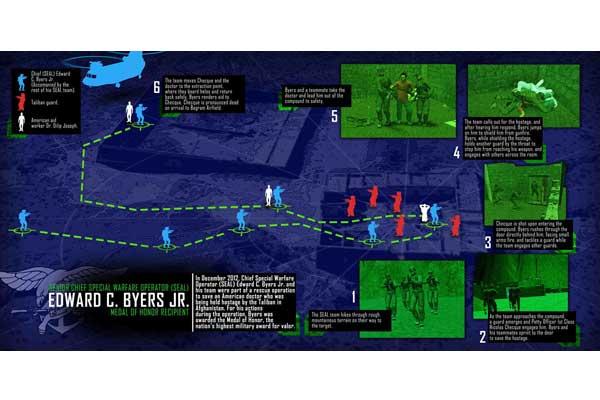In honor of National Medal of Honor Day, the U.S. Navy created an informational graphic depicting the December 2012 hostage-rescue mission that earned Senior Chief Special Warfare Operator Edward C. Byers Jr. the nation's highest award for valor.
On Feb. 29, the Navy SEAL received the Medal of Honor for his courageous actions on Dec. 8-9 while serving as part of a team that rescued American aid worker, Dr. Dilip Joseph, a civilian being held hostage in Afghanistan.
Congress has designated March 25 each year as National Medal of Honor Day to commemorate the day the first Medal of Honor was presented in 1863.
The prestigious award has "bestowed on 3,496 men and one woman (a Civil War surgeon) since President Abraham Lincoln signed it into law on Dec. 21, 1861," according to a Defense Department webpage honoring the 18 Medal of Honor recipients from Iraq and Afghanistan.
A high-resolution version of the info graphic can be found on the Navy's website at http://www.navy.mil/view_image.asp?id=212166.
Byers, 36, became the first living sailor since the Vietnam War to receive the honor. Two other SEALs, Lt. Michael Murphy and Petty Officer 2nd Class Michael Monsoor, received the Medal of Honor posthumously for heroism in Afghanistan and Iraq, respectively.
In all, six SEALs including Byers have received the medal; two of them, Retired Lt. Thomas Rolland Norris and Retired Lt. Michael Edwin Thornton, were present for the ceremony. In 1980, Thornton became the founding member of SEAL Team Six, the elite group of special operators to which Byers also belonged.
The rescue mission started on a cold December night. Byers and his team conducted a four-hour trek over mountainous terrain and primitive roads to where intelligence indicated Joseph was being held, in a compound in the Qarghah'i district of Laghman province.
Another member of the SEAL team, Petty Officer 1st Class Nicolas Checque, was the first into the compound, charging bravely to the entrance after a gate sentry was alerted to the presence of the team. He fell wounded from an AK-47 round to the head.
According to his summary of action, Byers was the second into the compound, sprinting in on Checque's heels. In the darkness, Byers first pulled down six layers of blankets that served as a primitive door, then began taking out enemy guards one by one.
He took down one man; then jumped on another, grappling with him physically on the ground until he could adjust his night-vision goggles and identify him as the enemy.
After that threat was dispatched, Byers and his teammates began calling out for Joseph to determine his location.
When the American doctor responded, Byers jumped on top of him, using his own body and body armor to protect the hostage. As he protected Joseph, Byers saw another enemy fighter armed with grenades. He managed to pin the man to the wall by his throat with one hand, allowing other members of his team to engage him.
After attending to Joseph and ensuring no more threats remained in the room, Byers turned his attention to Checque, using his background as a certified paramedic and former hospital corpsman to render aid and CPR during the wounded SEAL's flight to Bagram Air Base. Tragically, Checque would not survive his wounds.
"Byers went above and beyond the call of duty that evening, saving the life of the hostage, and earning the Medal of Honor," according to the Navy press release.
Of the 18 Medals of Honor awarded for Iraq and Afghanistan, three went to service members in the Navy -- Byers, Murphy and Monsoor. Three more of the awards went to Marines in the Marine Corps -- Cpl. William Kyle Carpenter, Cpl. Jason L. Dunham and Sgt. Dakota L. Meyer.
Meanwhile, 12 of the medals have gone to soldiers in the Army -- Staff Sgt. Ty Michael Carter, Staff Sgt. Salvatore A. Giunta, Capt. Florent A. Groberg, Spc. Ross A. McGinnis, Staff Sgt. Robert J. Miller, Sgt. 1st Class Jared C. Monti, Sgt. 1st Class Leroy A. Petry, Staff Sgt. Ryan Pitts, Staff Sgt. Clifton L. Romesha, Sgt. 1st Class Paul R. Smith, Capt. William D. Swenson and Sgt. Kyle J. White.
-- Matthew Cox can be reached at matthew.cox@military.com.
































